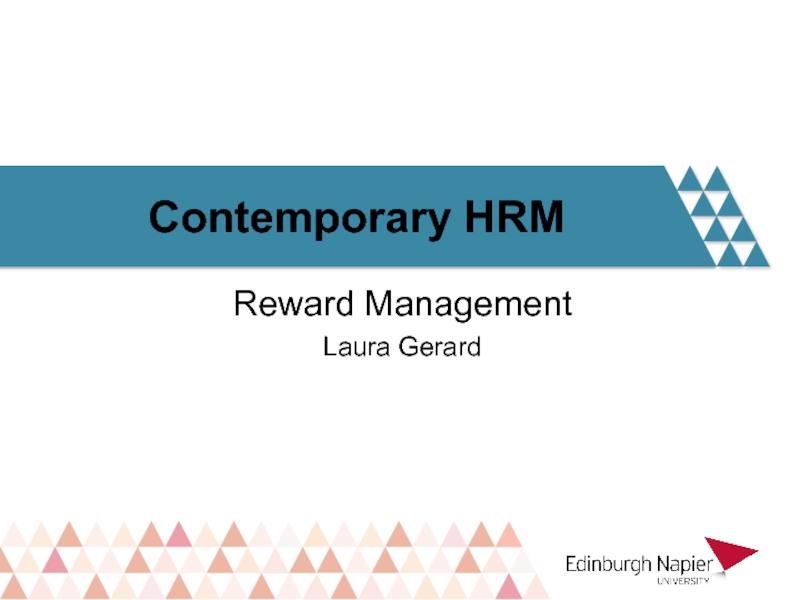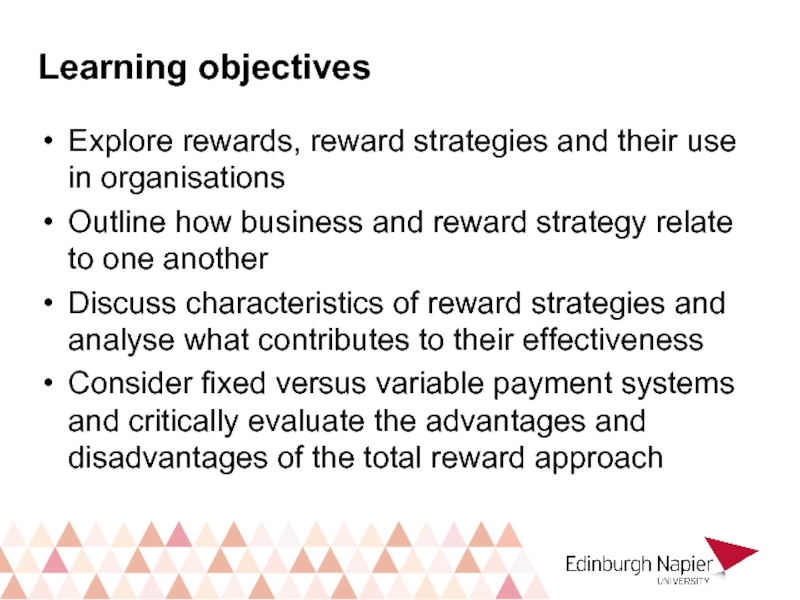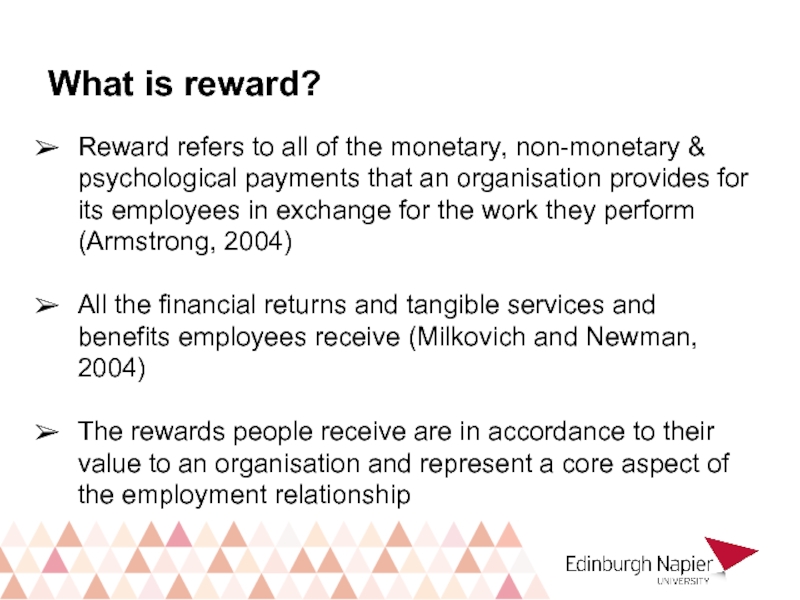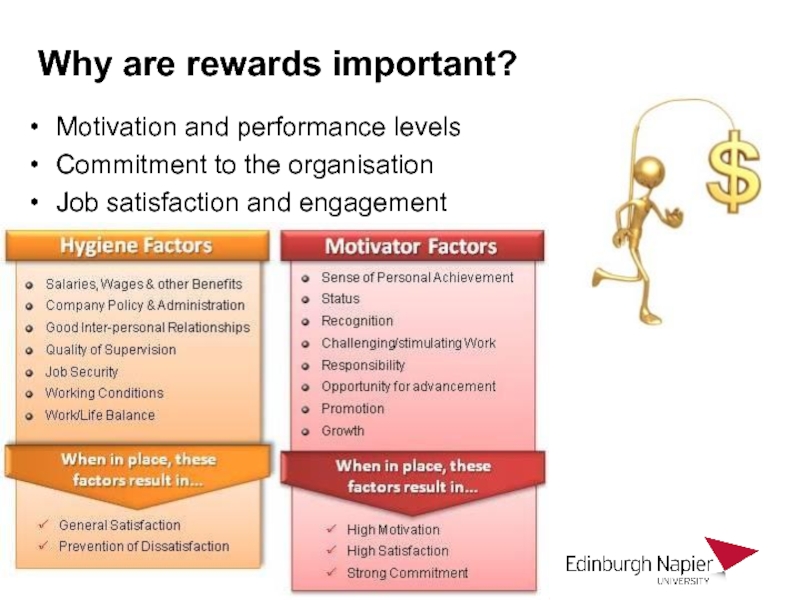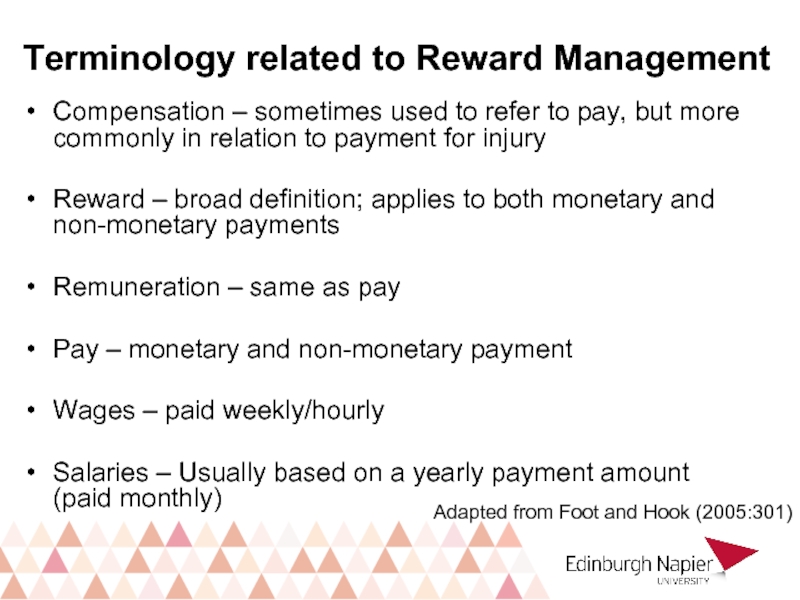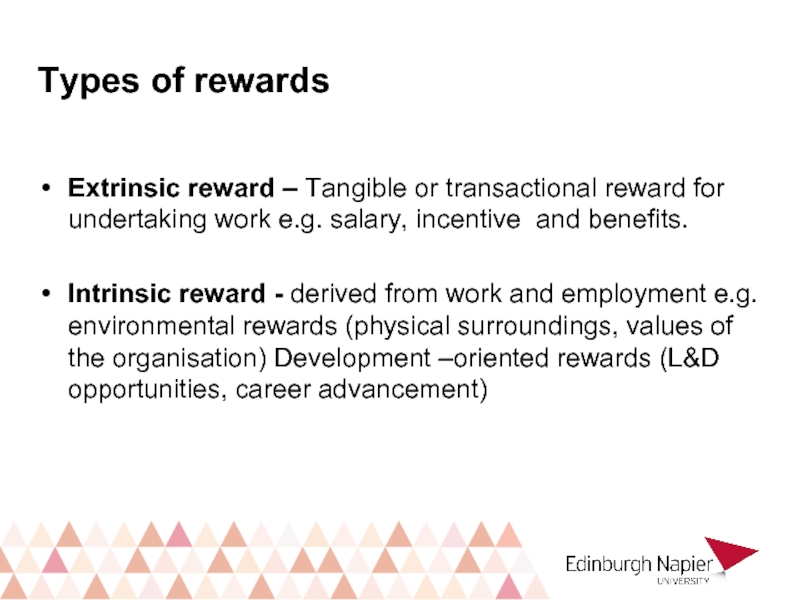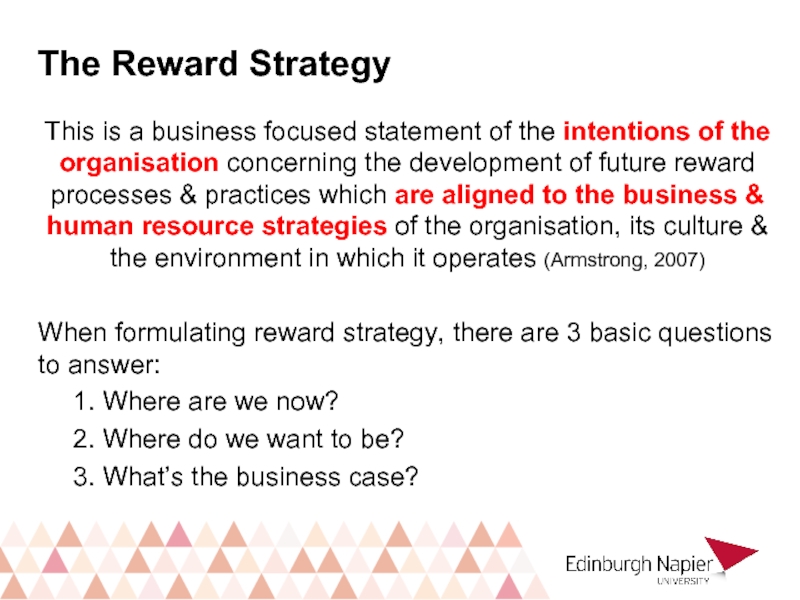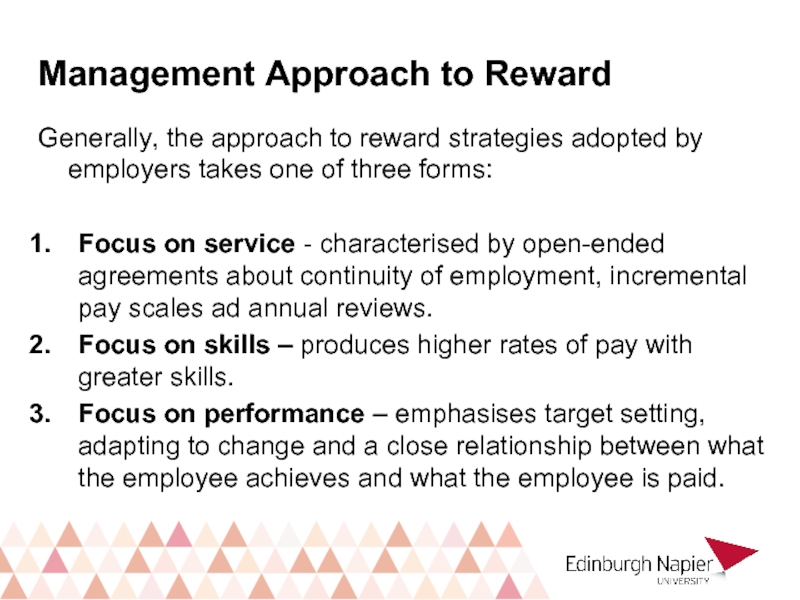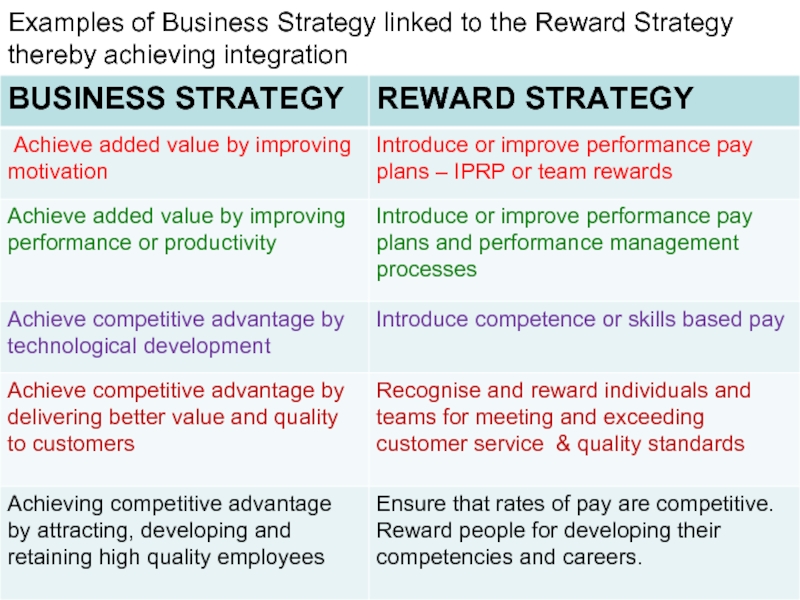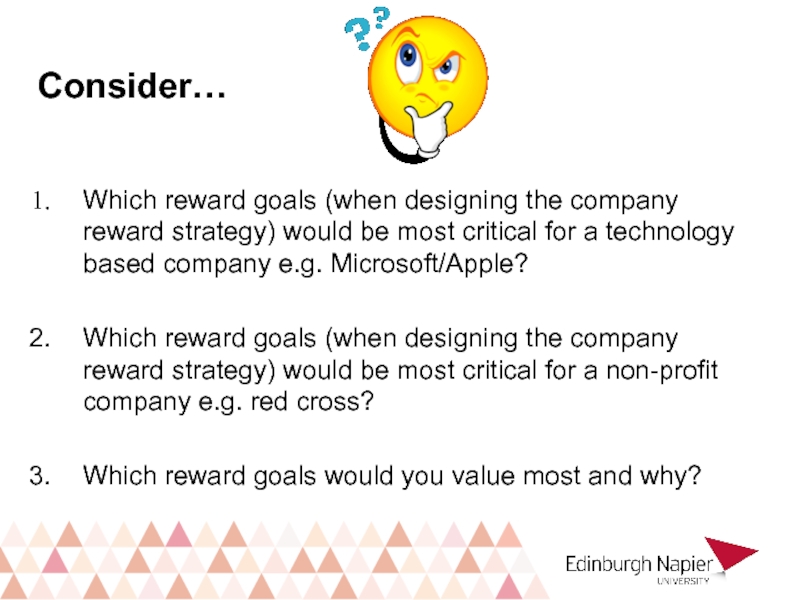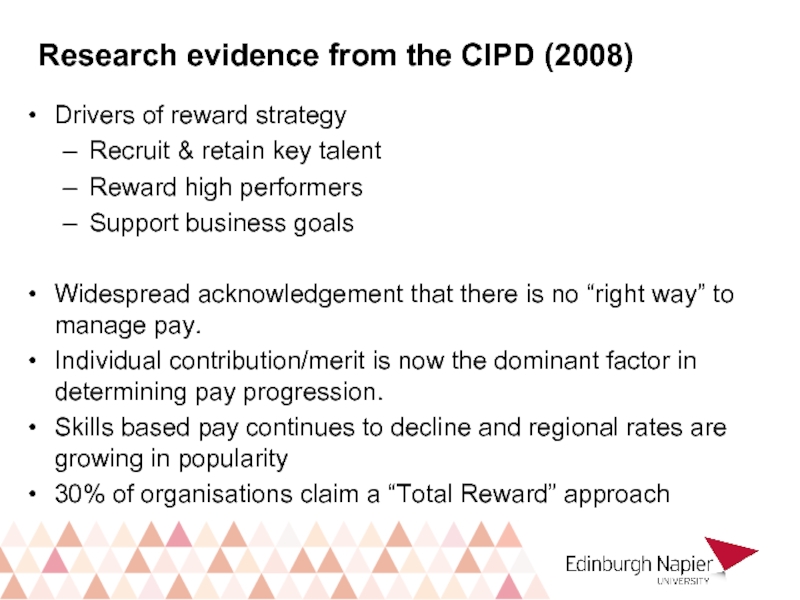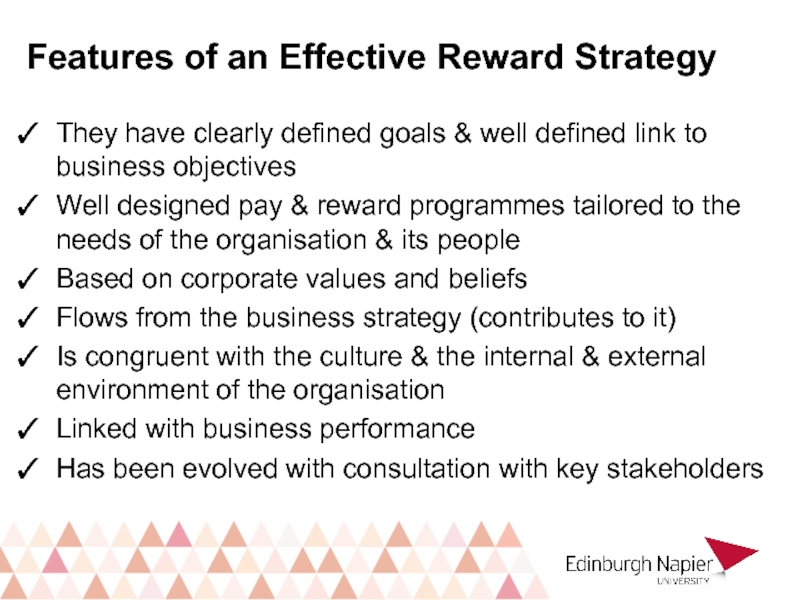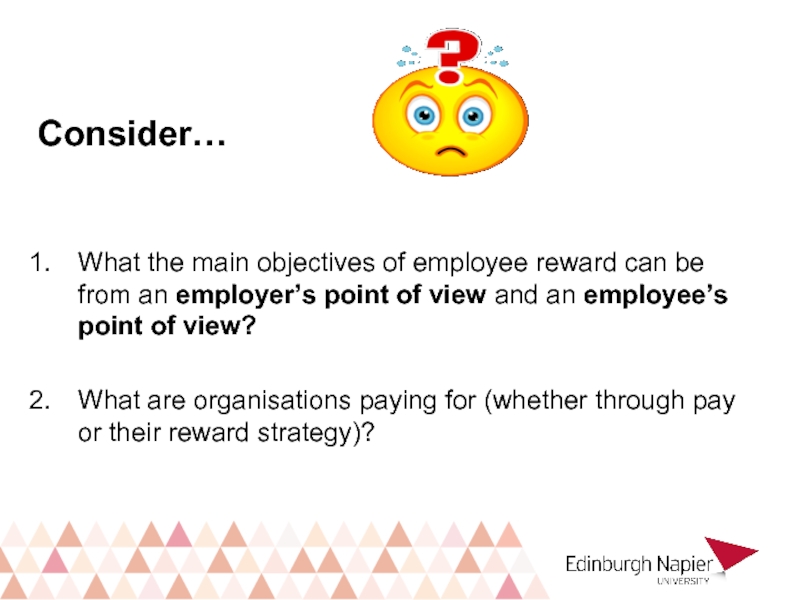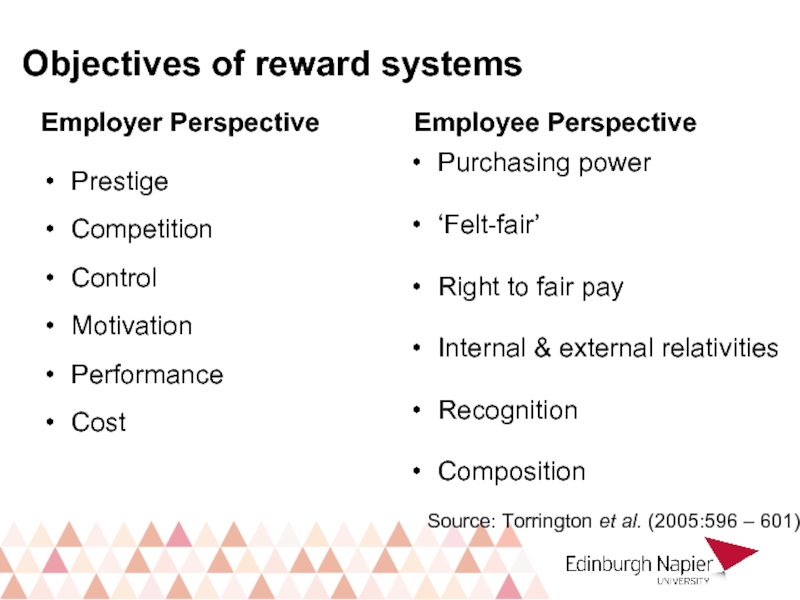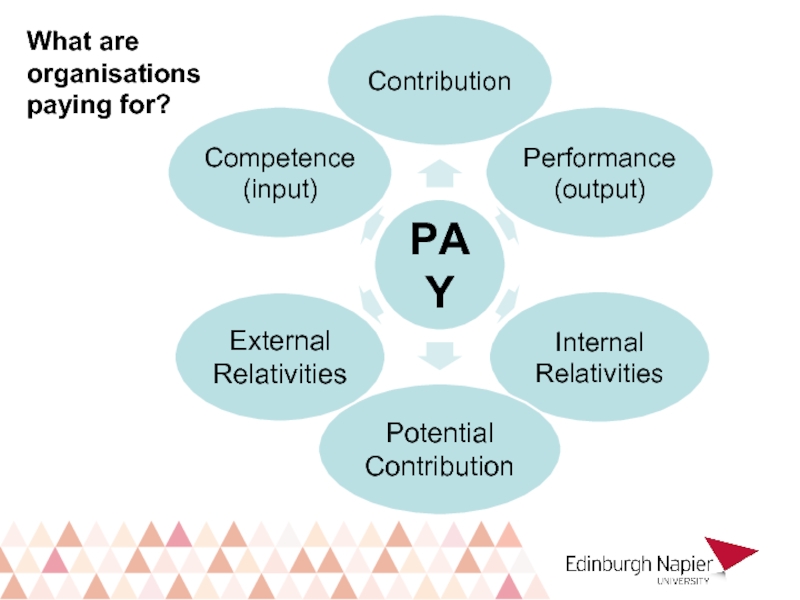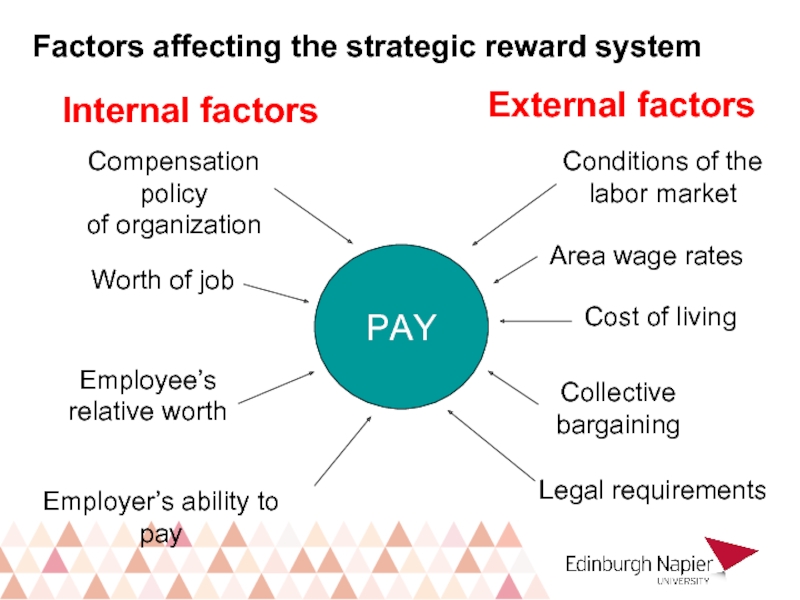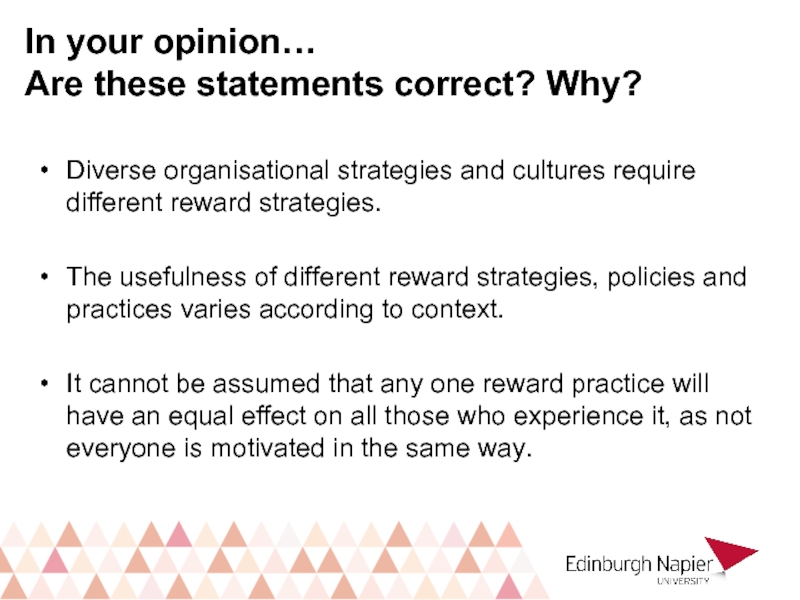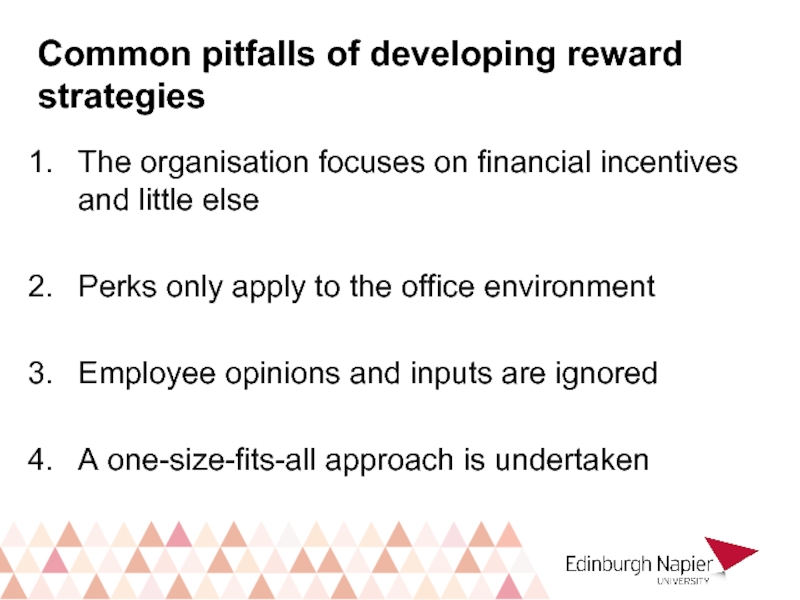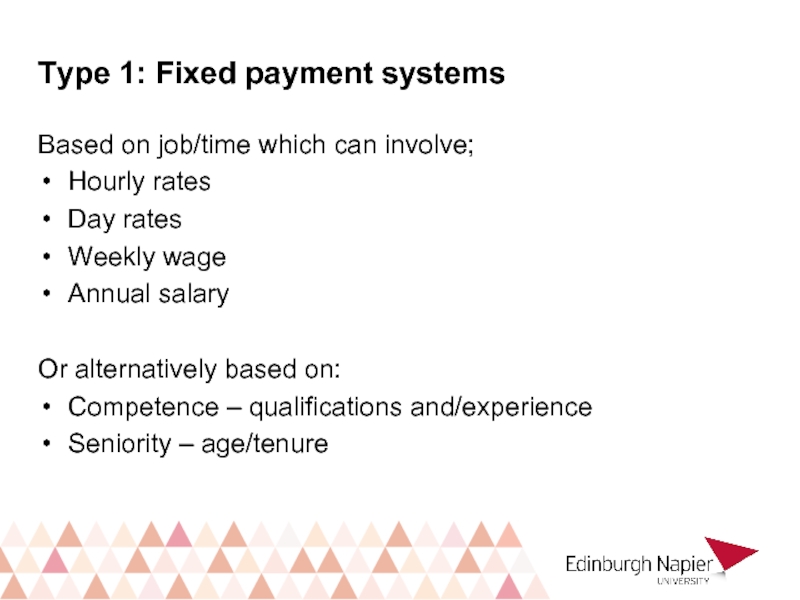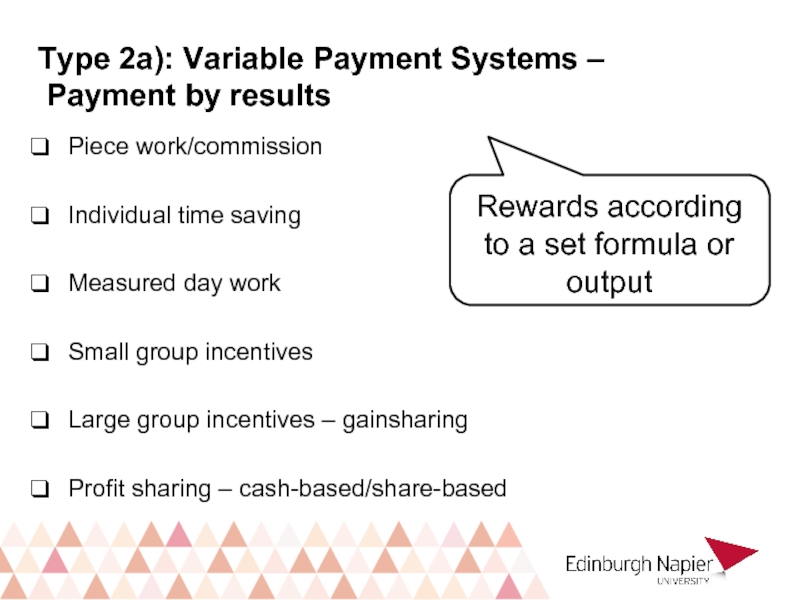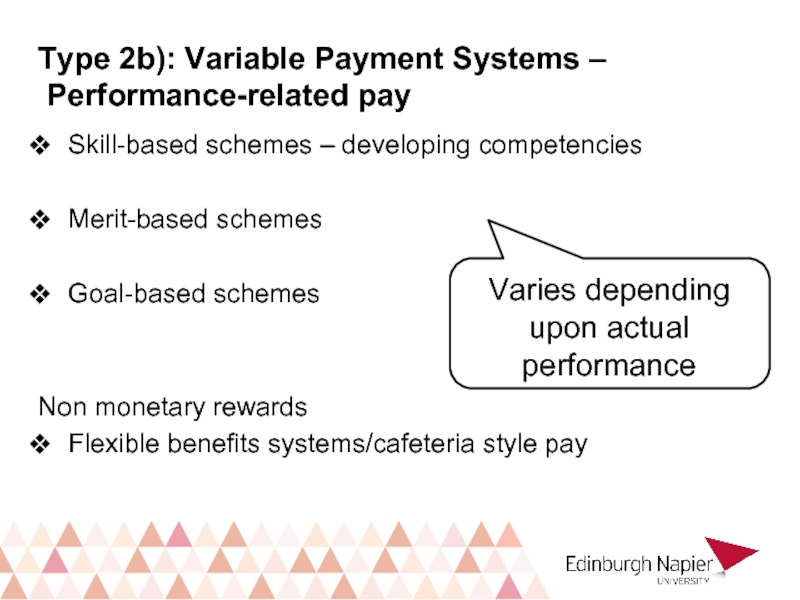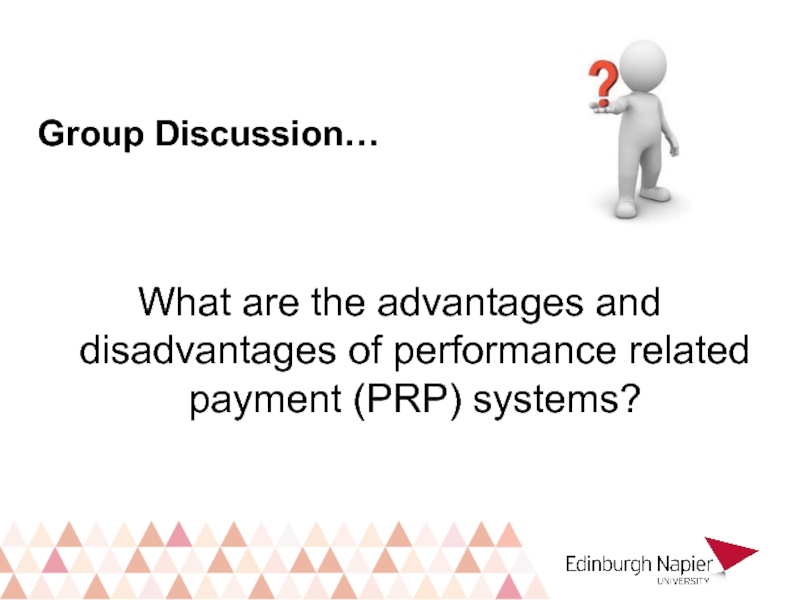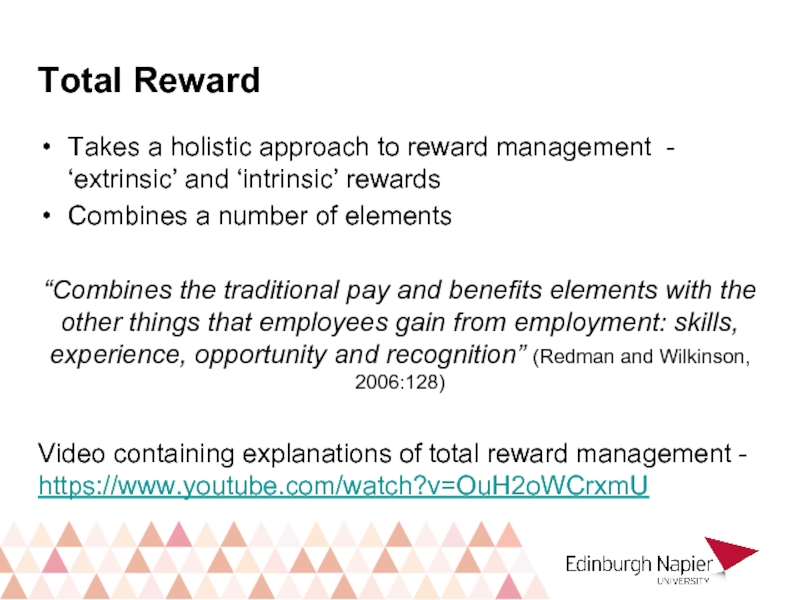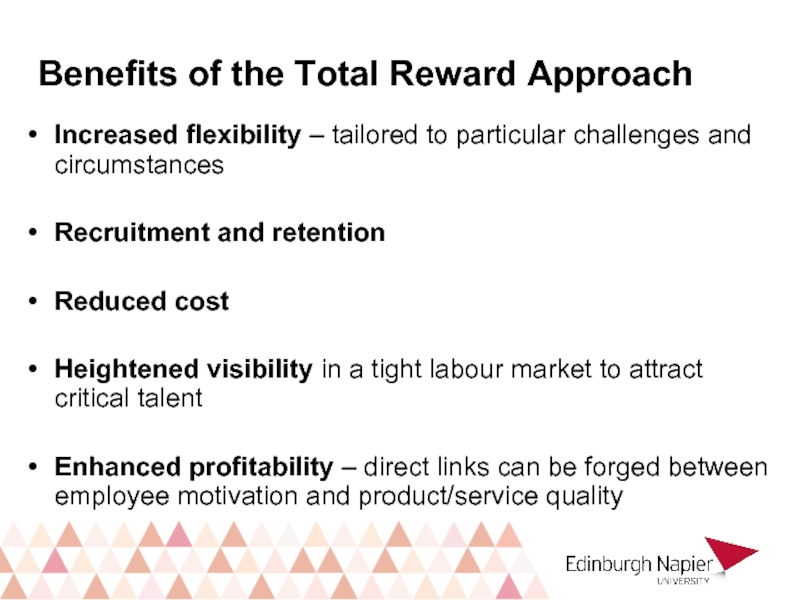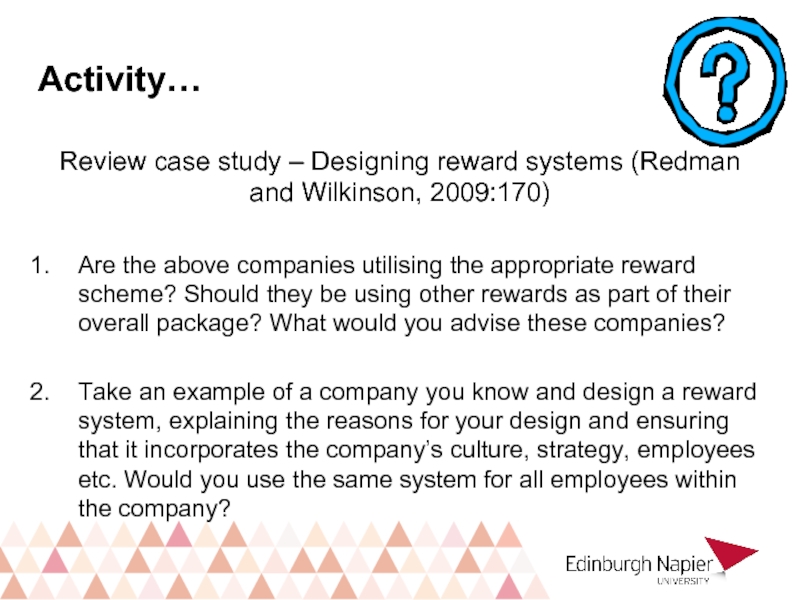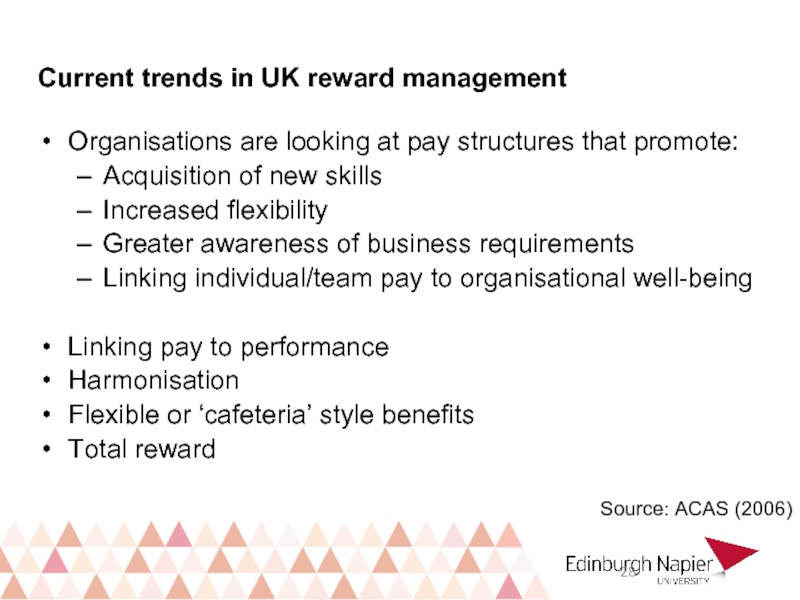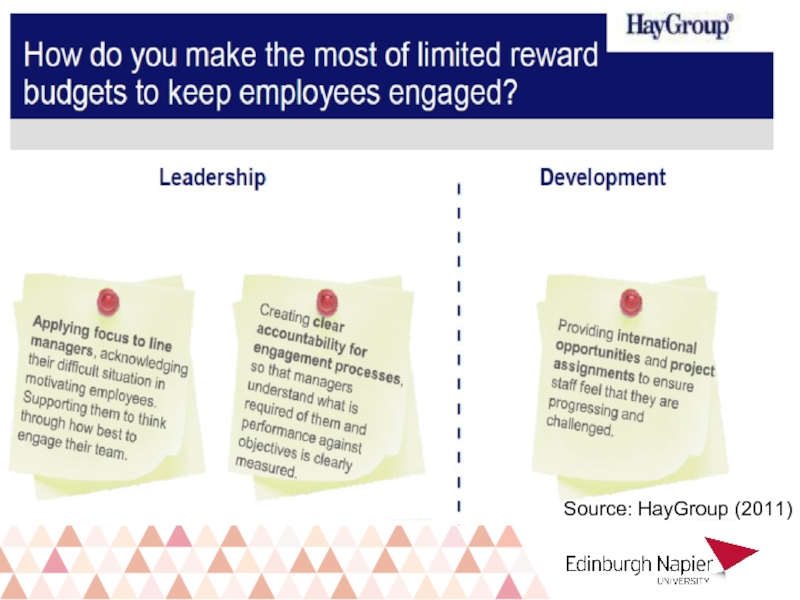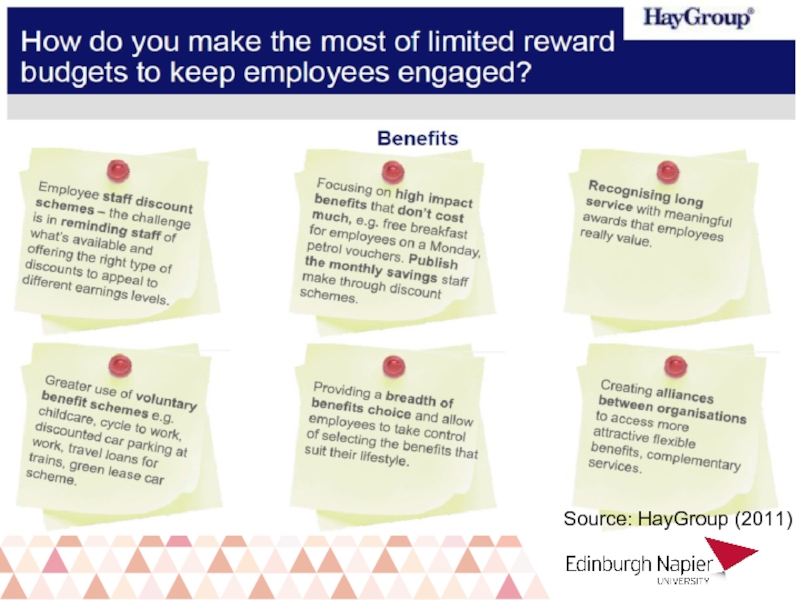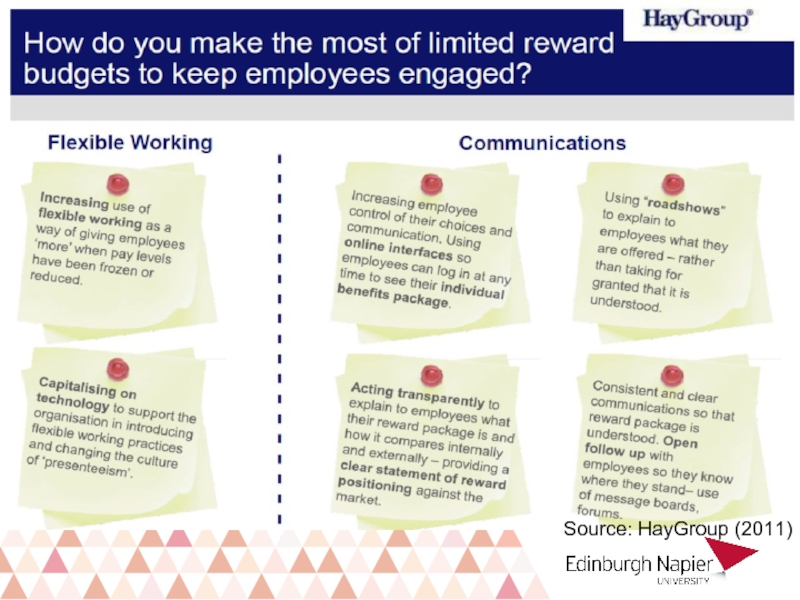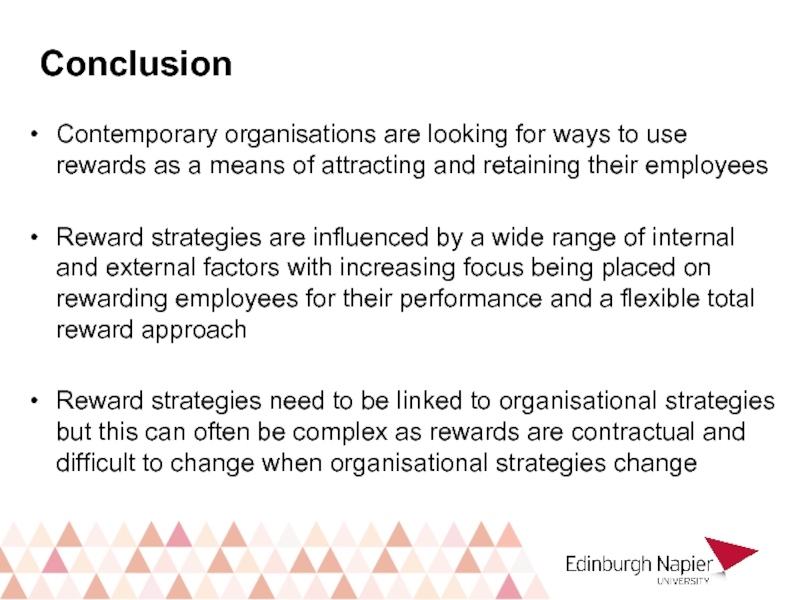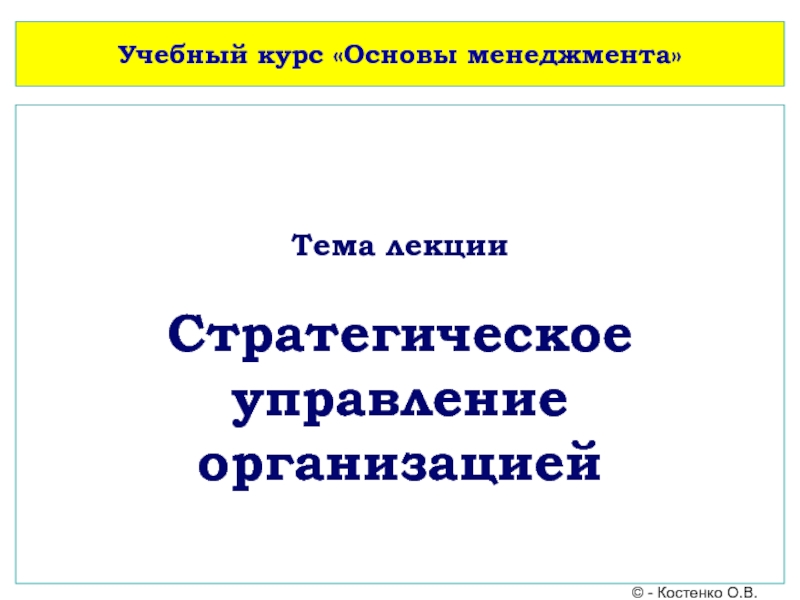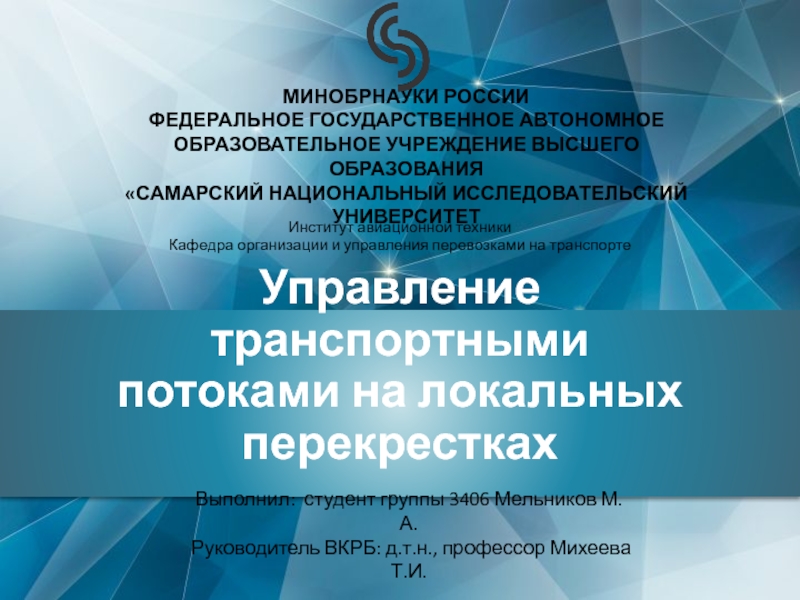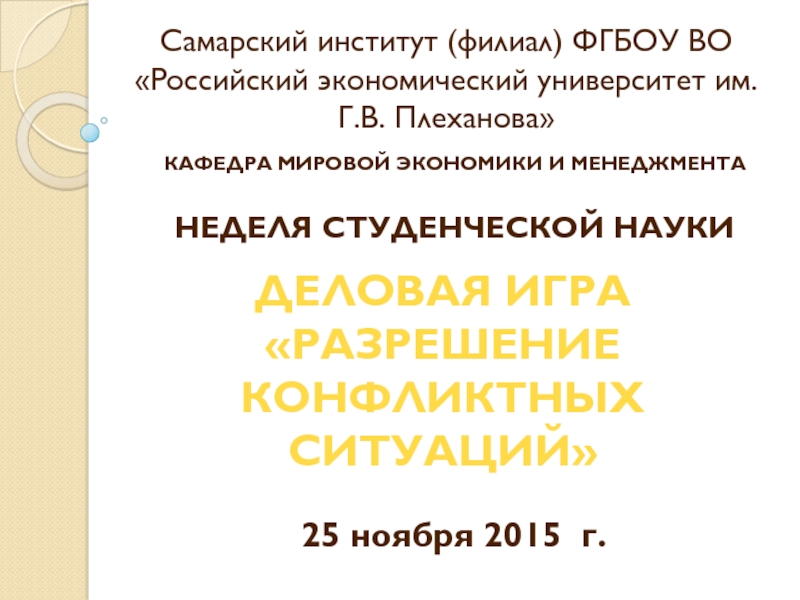- Главная
- Разное
- Дизайн
- Бизнес и предпринимательство
- Аналитика
- Образование
- Развлечения
- Красота и здоровье
- Финансы
- Государство
- Путешествия
- Спорт
- Недвижимость
- Армия
- Графика
- Культурология
- Еда и кулинария
- Лингвистика
- Английский язык
- Астрономия
- Алгебра
- Биология
- География
- Детские презентации
- Информатика
- История
- Литература
- Маркетинг
- Математика
- Медицина
- Менеджмент
- Музыка
- МХК
- Немецкий язык
- ОБЖ
- Обществознание
- Окружающий мир
- Педагогика
- Русский язык
- Технология
- Физика
- Философия
- Химия
- Шаблоны, картинки для презентаций
- Экология
- Экономика
- Юриспруденция
Contemporary HRM. Reward Management презентация
Содержание
- 1. Contemporary HRM. Reward Management
- 2. Learning objectives Explore rewards, reward strategies and
- 3. What is reward? Reward refers to all
- 4. Why are rewards important? Motivation and performance
- 5. Terminology related to Reward Management Compensation –
- 6. Types of rewards Extrinsic reward – Tangible
- 7. The Reward Strategy This is a business
- 8. Management Approach to Reward Generally, the approach
- 9. Examples of Business Strategy linked to the Reward Strategy thereby achieving integration
- 10. Consider… Which reward goals (when designing the
- 11. Research evidence from the CIPD (2008) Drivers
- 12. Features of an Effective Reward Strategy They
- 13. Consider… What the main objectives
- 14. Objectives of reward systems Employer Perspective Prestige
- 15. What are organisations paying for?
- 16. Factors affecting the strategic reward system PAY Internal factors External factors
- 17. In your opinion… Are these statements correct?
- 18. Common pitfalls of developing reward strategies The
- 19. Different types of reward system Two main
- 20. Type 1: Fixed payment systems Based on
- 21. Type 2a): Variable Payment Systems –
- 22. Skill-based schemes – developing competencies Merit-based
- 23. Group Discussion… What are the
- 24. Advantages of PRP Employees are able to
- 25. Total Reward Takes a holistic approach to
- 26. Benefits of the Total Reward Approach
- 27. Activity… Review case study – Designing reward
- 28. Current trends in UK reward management Organisations
- 29. Source: HayGroup (2011)
- 30. Source: HayGroup (2011)
- 31. Source: HayGroup (2011)
- 32. Conclusion Contemporary organisations are looking for ways
Слайд 2Learning objectives
Explore rewards, reward strategies and their use in organisations
Outline how
Discuss characteristics of reward strategies and analyse what contributes to their effectiveness
Consider fixed versus variable payment systems and critically evaluate the advantages and disadvantages of the total reward approach
Слайд 3What is reward?
Reward refers to all of the monetary, non-monetary &
All the financial returns and tangible services and benefits employees receive (Milkovich and Newman, 2004)
The rewards people receive are in accordance to their value to an organisation and represent a core aspect of the employment relationship
Слайд 4Why are rewards important?
Motivation and performance levels
Commitment to the organisation
Job
Слайд 5Terminology related to Reward Management
Compensation – sometimes used to refer to
Reward – broad definition; applies to both monetary and non-monetary payments
Remuneration – same as pay
Pay – monetary and non-monetary payment
Wages – paid weekly/hourly
Salaries – Usually based on a yearly payment amount (paid monthly)
Adapted from Foot and Hook (2005:301)
Слайд 6Types of rewards
Extrinsic reward – Tangible or transactional reward for undertaking
Intrinsic reward - derived from work and employment e.g. environmental rewards (physical surroundings, values of the organisation) Development –oriented rewards (L&D opportunities, career advancement)
Слайд 7The Reward Strategy
This is a business focused statement of the intentions
When formulating reward strategy, there are 3 basic questions to answer:
1. Where are we now?
2. Where do we want to be?
3. What’s the business case?
Слайд 8Management Approach to Reward
Generally, the approach to reward strategies adopted by
Focus on service - characterised by open-ended agreements about continuity of employment, incremental pay scales ad annual reviews.
Focus on skills – produces higher rates of pay with greater skills.
Focus on performance – emphasises target setting, adapting to change and a close relationship between what the employee achieves and what the employee is paid.
Слайд 10Consider…
Which reward goals (when designing the company reward strategy) would be
Which reward goals (when designing the company reward strategy) would be most critical for a non-profit company e.g. red cross?
Which reward goals would you value most and why?
Слайд 11Research evidence from the CIPD (2008)
Drivers of reward strategy
Recruit & retain
Reward high performers
Support business goals
Widespread acknowledgement that there is no “right way” to manage pay.
Individual contribution/merit is now the dominant factor in determining pay progression.
Skills based pay continues to decline and regional rates are growing in popularity
30% of organisations claim a “Total Reward” approach
Слайд 12Features of an Effective Reward Strategy
They have clearly defined goals &
Well designed pay & reward programmes tailored to the needs of the organisation & its people
Based on corporate values and beliefs
Flows from the business strategy (contributes to it)
Is congruent with the culture & the internal & external environment of the organisation
Linked with business performance
Has been evolved with consultation with key stakeholders
Слайд 13Consider…
What the main objectives of employee reward can be from an
What are organisations paying for (whether through pay or their reward strategy)?
Слайд 14Objectives of reward systems
Employer Perspective
Prestige
Competition
Control
Motivation
Performance
Cost
Employee Perspective
Purchasing power
‘Felt-fair’
Right to fair pay
Internal &
Recognition
Composition
Source: Torrington et al. (2005:596 – 601)
Слайд 17In your opinion…
Are these statements correct? Why?
Diverse organisational strategies and cultures
The usefulness of different reward strategies, policies and practices varies according to context.
It cannot be assumed that any one reward practice will have an equal effect on all those who experience it, as not everyone is motivated in the same way.
Слайд 18Common pitfalls of developing reward strategies
The organisation focuses on financial incentives
Perks only apply to the office environment
Employee opinions and inputs are ignored
A one-size-fits-all approach is undertaken
Слайд 19Different types of reward system
Two main categories:
Fixed payment systems = Those
Variable payment systems = Those that vary in relation to results, profits, or performance (based on payment by results or performance related pay)
Слайд 20Type 1: Fixed payment systems
Based on job/time which can involve;
Hourly rates
Day
Weekly wage
Annual salary
Or alternatively based on:
Competence – qualifications and/experience
Seniority – age/tenure
Слайд 21Type 2a): Variable Payment Systems –
Payment by results
Piece work/commission
Individual time
Measured day work
Small group incentives
Large group incentives – gainsharing
Profit sharing – cash-based/share-based
Rewards according to a set formula or output
Слайд 22Skill-based schemes – developing competencies
Merit-based schemes
Goal-based schemes
Non monetary rewards
Flexible benefits systems/cafeteria
Varies depending upon actual performance
Type 2b): Variable Payment Systems –
Performance-related pay
Слайд 23Group Discussion…
What are the advantages and disadvantages of performance related payment
Слайд 24Advantages of PRP
Employees are able to influence performance by changing their
The reward is clearly & closely linked to the effort of the individual or group
Employees are clear about the targets & standards of performance needed & can measure their own performance against these targets
Performance can be measured with fairness & consistency
The pay system uses a clearly defined & understood formula
Can encourage an entrepreneurial & performance oriented culture
Disadvantages of PRP
Encourages compliance rather than commitment
Short-term motivation – Hertzberg (1966)
Unlikely to improve poor performance
Stifle creativity and innovation
Reliance on line manager’s skills as assessors
Can lead to Equal Pay claims
Source: Torrington et al. (2014)
Слайд 25Total Reward
Takes a holistic approach to reward management - ‘extrinsic’ and
Combines a number of elements
“Combines the traditional pay and benefits elements with the other things that employees gain from employment: skills, experience, opportunity and recognition” (Redman and Wilkinson, 2006:128)
Video containing explanations of total reward management - https://www.youtube.com/watch?v=OuH2oWCrxmU
Слайд 26Benefits of the Total Reward Approach
Increased flexibility – tailored to
Recruitment and retention
Reduced cost
Heightened visibility in a tight labour market to attract critical talent
Enhanced profitability – direct links can be forged between employee motivation and product/service quality
Слайд 27Activity…
Review case study – Designing reward systems (Redman and Wilkinson, 2009:170)
Are
Take an example of a company you know and design a reward system, explaining the reasons for your design and ensuring that it incorporates the company’s culture, strategy, employees etc. Would you use the same system for all employees within the company?
Слайд 28Current trends in UK reward management
Organisations are looking at pay structures
Acquisition of new skills
Increased flexibility
Greater awareness of business requirements
Linking individual/team pay to organisational well-being
Linking pay to performance
Harmonisation
Flexible or ‘cafeteria’ style benefits
Total reward
Source: ACAS (2006)
Слайд 32Conclusion
Contemporary organisations are looking for ways to use rewards as a
Reward strategies are influenced by a wide range of internal and external factors with increasing focus being placed on rewarding employees for their performance and a flexible total reward approach
Reward strategies need to be linked to organisational strategies but this can often be complex as rewards are contractual and difficult to change when organisational strategies change
